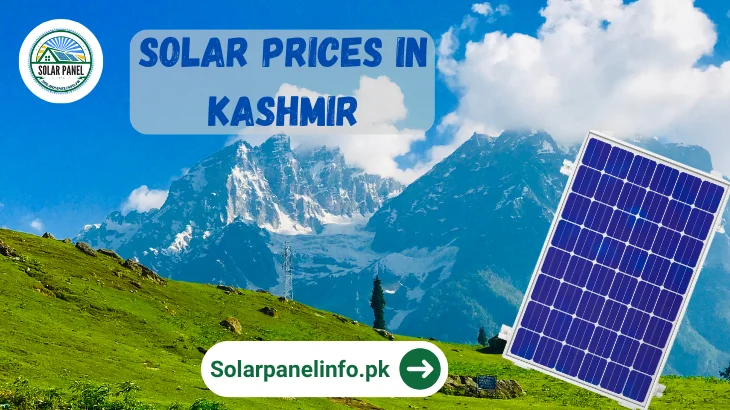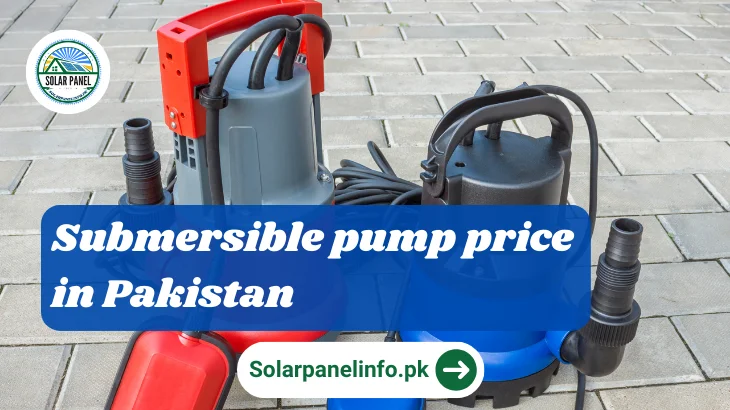Solar Prices in Kashmir
Kashmir, known for its unspoiled beauty and diverse climate, possesses significant potential for renewable energy, especially solar energy. The area benefits from plenty of sunshine during the warmer seasons, making it a suitable spot for solar power system installations. As awareness of climate change, energy security, and sustainable development grows, solar energy is becoming a vital solution for this region. This article offers a detailed overview of the current trends in solar pricing in Kashmir, the factors impacting them, and the possibilities for solar energy development in the area.
Read more: Solar Panel Prices In Faisalabad 2025

کشمیر، اپنی بے ساختہ خوبصورتی اور متنوع آب و ہوا کے لیے جانا جاتا ہے، قابل تجدید توانائی، خاص طور پر شمسی توانائی کے لیے قابل قدر صلاحیت رکھتا ہے۔ یہ علاقہ گرم موسموں میں دھوپ کی کافی مقدار سے فائدہ اٹھاتا ہے، جس سے یہ شمسی توانائی کے نظام کی تنصیبات کے لیے موزوں جگہ بنتا ہے۔ جیسے جیسے موسمیاتی تبدیلی، توانائی کی حفاظت، اور پائیدار ترقی کے بارے میں آگاہی بڑھ رہی ہے، شمسی توانائی اس خطے کے لیے ایک اہم حل بن رہی ہے۔ یہ مضمون کشمیر میں شمسی توانائی کی قیمتوں میں موجودہ رجحانات، ان پر اثر انداز ہونے والے عوامل اور علاقے میں شمسی توانائی کی ترقی کے امکانات کا تفصیلی جائزہ پیش کرتا ہے۔
The Growing Demand for Solar Energy in Kashmir
Kashmir’s power supply has traditionally depended on hydropower, which is susceptible to seasonal fluctuations, particularly in winter when water flow decreases. This often results in power shortages and electricity rationing, especially in rural and remote areas. Solar energy is viewed as a potentially transformative solution, providing a reliable, sustainable, and cost-effective alternative. Moreover, with both the state government and the Indian government promoting a transition to green energy, there has been a growing interest in solar energy installations for both residential and commercial use.
Current Solar Prices in Kashmir
The cost of solar power systems in Kashmir can change depending on a few things, like the type of system you choose, how big the installation is, and any government subsidies that might be available. Here’s a friendly breakdown of what to expect when considering solar installations in Kashmir:
Residential Solar Systems(رہائشی شمسی نظام)
- Small Systems (1-2 kW): The cost of a basic residential system can vary from INR 40,000 to INR 60,000, based on the quality of components like solar panels, inverters, and batteries.
- Medium Systems (3-5 kW): A system designed for larger homes or businesses, ranging from 3 to 5 kW, can be priced between INR 1.5 lakh and INR 3 lakh.
- Large Systems (Above 5 kW): For larger residential configurations, which may suit bigger homes or larger establishments, the price can range from INR 3 lakh to over INR 6 lakh, depending on the specific requirements.
Commercial Solar Systems(تجارتی نظام شمسی)
For commercial real estate, costs are usually expressed on a per kilowatt (kW) basis. The price per kW generally falls between INR 40,000 and INR 50,000 for a medium-sized commercial solar power system. Larger setups, like those utilized for industrial applications, may benefit from even more favorable pricing because of bulk purchases and the size of the installation.
Government Subsidies and Incentives
The Jammu & Kashmir government, along with the central government, is working hard to make solar energy more accessible and affordable for everyone in the region, whether you’re a homeowner or a business owner.
Here are some of the great incentives and subsidies available:
Subsidy for Residential Solar Systems(رہائشی شمسی نظام کے لیے سبسڈی)
If you’re thinking about switching to solar energy for your home, you’re in luck! The central government, through the Ministry of New and Renewable Energy (MNRE), offers a fantastic subsidy of up to 30% for residential solar installations. This can help lower the overall cost and make solar power a more appealing option.
Capital Subsidy for Commercial Installations(تجارتی تنصیبات کے لیے کیپٹل سبسڈی)
For businesses looking to go solar, there’s good news too! While the subsidy rates may vary, the government often provides financial assistance to help ease the transition to solar energy, making it simpler for companies to make the switch.
Net Metering Facility(نیٹ میٹرنگ کی سہولت)
One awesome benefit for solar users is net metering. This means that if your solar system generates more energy than you use, you can sell that surplus energy back to the grid! It’s a great way to offset installation costs over time and enjoy a little extra income from your solar investment.
So, if you’re considering solar energy, now is a great time to explore your options and take advantage of these incentives!
Factors Affecting Solar Prices in Kashmir
Here are some key factors that can influence solar prices in Kashmir. Keeping these in mind can help you make better choices:
Quality of Components(اجزاء کا معیار)
The price of a solar system largely depends on the quality of its components, like solar panels, inverters, and batteries. While premium-quality panels may have a higher upfront cost, they’re often more durable and efficient, providing better returns over time.
Installation and Maintenance Costs(تنصیب اور دیکھ بھال کے اخراجات)
Even though solar panels can be pricey at first, maintenance costs are usually pretty low. Installation costs can vary based on how complex the project is and where it’s located, so it’s good to get a clear estimate.
Weather Conditions( موسمی حالات)
Kashmir’s chilly winters can impact how solar panels perform and how long they last. Manufacturers take these local climate factors into account when pricing their systems. So, if you see systems designed to handle snow and freezing temperatures, they might be priced a bit higher.
Market Competition(مارکیٹ کا مقابلہ)
As more solar companies and installers enter the Kashmir market, prices are likely to become more competitive, which could mean more affordable options for you!
By considering these factors, you can make a more informed decision about going solar!
Advantages of Solar Energy in Kashmir
The adoption of solar energy in Kashmir offers several significant benefits:
Cost Savings(لاگت کی بچت)
Once installed, solar energy systems can greatly lower electricity bills, particularly in areas with abundant sunlight. Over time, the initial investment becomes cost-effective.
Reliability(وشوسنییتا)
Solar energy serves as a dependable power source, especially in remote areas where the grid supply is either unreliable or unavailable.
Environmentally Friendly(ماحول دوست)
Solar energy is a clean and renewable power source, which helps to decrease the region’s carbon footprint and mitigate the effects of climate change.
Energy Independence(توانائی کی آزادی)
Utilizing solar energy can reduce reliance on external power sources, enhancing energy security in a region like Kashmir, where energy shortages are common.
Challenges in Solar Energy Adoption in Kashmir
Despite the numerous advantages of solar energy, there are several challenges to its widespread adoption in Kashmir:
Initial Investment(ابتدائی سرمایہ کاری)
The upfront cost of installing solar systems is a significant barrier for many households and businesses. Although subsidies are available, the total cost can still be prohibitive for some.
Weather and Snowfall(موسم اور برف باری)
Heavy snowfall and harsh winters present challenges for solar energy systems. Snow accumulation on solar panels can reduce their efficiency and may necessitate regular cleaning and maintenance.
Grid Connectivity(گرڈ کنیکٹیویٹی)
In remote areas, unreliable grid connectivity complicates the integration of solar energy with the national grid. This limitation affects the feasibility of net metering and selling excess power back to the grid.
Future Outlook for Solar Energy in Kashmir
The future of solar energy in Kashmir looks promising due to the Indian government’s goal of achieving 500 GW of non-fossil fuel energy capacity by 2030. With advances in technology and decreasing solar panel prices, solar energy is becoming more affordable and accessible. Local government initiatives to promote solar installations and provide financial support will further enhance growth in the sector. Increased awareness of environmental issues is expected to accelerate the transition to clean energy.
Conclusion
Solar energy presents a fantastic chance for the beautiful region of Kashmir to become energy-independent, sustainable, and environmentally friendly! While the costs of solar systems can vary for different reasons, the good news is that with the government Solar scheme, incentives, subsidies, and the dropping prices of technology, solar power is becoming more accessible to everyone in Kashmir. With ongoing support and investment in solar energy, the region can look forward to enjoying amazing economic, environmental, and social benefits in the years ahead.
شمسی توانائی کشمیر کے خوبصورت خطے کے لیے توانائی سے خود مختار، پائیدار اور ماحول دوست بننے کا ایک شاندار موقع پیش کرتی ہے! اگرچہ شمسی نظام کی قیمتیں مختلف وجوہات کی بناء پر مختلف ہو سکتی ہیں، لیکن اچھی خبر یہ ہے کہ حکومتی مراعات اور ٹیکنالوجی کی گرتی ہوئی قیمتوں کے ساتھ، کشمیر میں شمسی توانائی ہر کسی کے لیے زیادہ قابل رسائی ہوتی جا رہی ہے۔ شمسی توانائی میں جاری تعاون اور سرمایہ کاری کے ساتھ، یہ خطہ آنے والے سالوں میں حیرت انگیز اقتصادی، ماحولیاتی اور سماجی فوائد سے لطف اندوز ہونے کا منتظر ہے۔
FAQ’s
What is the cost of a residential solar system in Kashmir?
- Small residential solar systems (1-2 kW) cost between INR 40,000 to INR 60,000.
- Larger systems (3-5 kW) range from INR 1.5 lakh to INR 3 lakh.
- Systems above 5 kW may cost from INR 3 lakh to over INR 6 lakh.
Are there any government subsidies for solar systems in Kashmir?
The central government provides a subsidy of up to 30% for residential solar installations, along with subsidies for commercial installations. Additionally, a net metering facility allows consumers to sell surplus energy back to the grid.
What are the main challenges in adopting solar energy in Kashmir?
The main challenges are high initial investment, harsh weather conditions (like snow accumulation), and unreliable grid connectivity in remote areas, all of which can affect installation and long-term performance.


